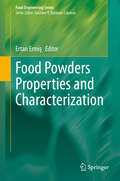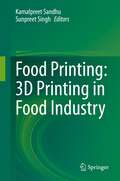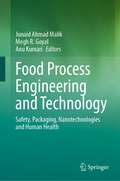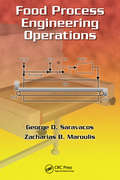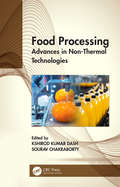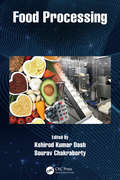- Table View
- List View
Food Powders Properties and Characterization (Food Engineering Series)
by Ertan ErmişFood powders are an increasingly important aspect of processed food worldwide. Essential factors such as ease of storage and transport and usage convenience have greatly benefited the food industry and promise further advancements in processing techniques. Food powders can be stored for a longer period of time than other food products, making them essential for food supply in many regions of the world. There have been numerous research works on food powders properties and characterization, but there has not been an updated comprehensive review in this field. Food Powders Properties and Characterization is designed as an essential reference for individuals in the food industry and academia seeking a singular source that covers most of the basic aspects of food powders. With chapters focusing on the general properties of food powders, characterization of particle and bulk properties, adhesion and surface properties, this text presents comprehensive and fully up to date coverage of this challenging and important field.
Food Preservation and Biodeterioration
by Gary S. TuckerBiodeterioration is the breakdown of food by agents of microbiological origin, either directly or indirectly from products of their metabolism. Preservation on the other hand is the process by which food materials are maintained in their original condition or as close to this as possible. This second edition of Food Preservation and Biodeterioration is fully updated and reorganised throughout. It discusses how the agents of food biodeterioration operate and how the commercial methods available to counteract these agents are applied to produce safe and wholesome foods. With this book, readers will discover traditional methods as well as major advances in preservation technology. Both microbiological and chemical pathways are analysed. This topic being important to all producers of food, the readership spans food scientists across industry and academia, particularly those involved with safety and quality.
Food Preservation and Biodeterioration
by Gary S. TuckerBiodeterioration is the breakdown of food by agents of microbiological origin, either directly or indirectly from products of their metabolism. Preservation on the other hand is the process by which food materials are maintained in their original condition or as close to this as possible. This second edition of Food Preservation and Biodeterioration is fully updated and reorganised throughout. It discusses how the agents of food biodeterioration operate and how the commercial methods available to counteract these agents are applied to produce safe and wholesome foods. With this book, readers will discover traditional methods as well as major advances in preservation technology. Both microbiological and chemical pathways are analysed. This topic being important to all producers of food, the readership spans food scientists across industry and academia, particularly those involved with safety and quality.
Food Preservation in Developing Countries: Challenges and Solutions
by Mohammad U. Joardder Mahadi Hasan MasudThis text identifies common mistakes and challenges in food preservation in developing countries, offering solutions which can play a significant role in reducing food waste in these countries. The book offers critical analysis of current preservation techniques for fruits and vegetables, meat, fish, dairy, and grain, identifying key mistakes and challenges and proposing effective solutions. Feasibility tests for implementing these innovative approaches are also presented. A well-rounded study of the various causes of food waste in developing nations, this book plays a key role in bringing effective food preservation methods to the developing world. Food Preservation in Developing Countries: Challenges and solutions studies common food preservation techniques for fruits and vegetables, fish, meat, dairy, and grains, pinpointing the areas where waste occurs due to transportation, contamination, and low quality post processing. Innovative potential solutions are presented, including the feasibility of implementation of these advanced preservation techniques. The book takes a critical look at barriers to proper food preservation in these regions and offers practical solutions which can be implemented in a cost effective and timely manner. With almost one third of the world's food supply wasted each year and 13% of the world's inhabitants going hungry, this is an incredibly important and timely text.
Food Preservatives
by Grahame W. Gould N. J. RussellFor centuries man has treated food to prolong its edible life, and nowadays both traditional and modern preservatives are used widely to ensure the satisfactory maintenance of quality and safety of foods. There continues to be increased public concern about the use of food additives, including preservatives, resulting from a perception that some of them may have deleterious effects on health. However, as eating habits have changed with an emphasis on what has been popularly termed a `healthy diet', there is at the same time a concern that reduction in preservative usage could lead to loss of safety and protection from food poisoning. While some preservatives are coming under increasing regulatory pressure others, particularly more natural ones, are receiving increased attention and gaining in importance and acceptability. This book supports the continued safe and effective use of preservatives within these current constraints. It therefore gives detailed information on the practical use of the major antimicrobial preservatives. Uniquely, it couples this with current understanding of their modes of action, at the levels of cellular physiology and biochemistry, in such a way as to provide a sound scientific basis for their efficacy. Such an approach also encourages the future logical development and use of preservatives.
Food Printing: 3D Printing in Food Industry
by Kamalpreet Sandhu Sunpreet SinghThis book provides a comprehensive overview of the technical notes, research designs, literature, and 3DP (three-dimensional printing) technology applications for effective food printing. It provides a multidisciplinary coverage of 3D food printing in different food sectors. Recent advancements in manufacturing processes have led food industries to create innovations to stay competitive in the market. 3D food printing incorporates 3DP digital gastronomy strategies to manufacture food products with consistency in shape, color, flavor, texture, and even nutrition. Thus, by controlling the number of materials and the quality of nutrients, food items can be manufactured and handled to fulfill their particular requirements. For food printing, both proprietary structures and self-developed frameworks are used from open sources. Similar frameworks are re-engineered to reformulate administration, content creation, and user interface. For example, three printing medium types, natural printable products, non-printable synthetic food products, and alternative ingredients as well as two recipe forms (i.e., element-based recipes and regular recipes) are used for customized food production. The authors address that open 3D technology for food printing and food processing technology are theoretically correlated with food printing. The book will help industrial designers, nutrition professionals, dieticians, manufacturing enterprises, and young researchers in food technology, material science, and mechanical engineering understand the latest advances in 3DP technology in food industries.
Food Process Design and Evaluation
by Rakesh K. SinghThis book provides detailed illustrated reports on important recent advances in processing of foods including separation, mixing, preservation, and extrusion. The authors are specialists in food processing from North America and Europe. The reports were originally presented at the Conference of Food Engineering sponsored by the American Institute of Chemical Engineers in 1992 and 1993; they were selected, rewritten and updated for this book.
Food Process Design and Evaluation
by Rakesh Kumar SinghThis book provides detailed illustrated reports on important recent advances in processing of foods including separation, mixing, preservation, and extrusion. The authors are specialists in food processing from North America and Europe. The reports were originally presented at the Conference of Food Engineering sponsored by the American Institute of Chemical Engineers in 1992 and 1993; they were selected, rewritten and updated for this book.
Food Process Engineering
by H.A. Leniger W.A. BeverlooThis book resulted from many years of teaching engineering aspects of food tech nology at the Agricultural University ofWageningen, The Netherlands. In the course of those years the subject matter of teaching has been written down and placed at the student's disposal. The Dutch text has been reconsidered and revised several times. Eventually the question arose whether it would be advisable to transform and translate the text in order to transfer available knowledge and experience to others interested in the relatively new branch of food science that food process engineering is. This question has been answered in the affirmative. Up to now only a few books deal with food process engineering; some are rather superficial and evidently meant as introductory, other ones have in our opinion too much emphasis on chemical engineering and too little on food process engineering. We believe - and this will be elucidated at some length in the Introduction - that food process engineering is in many respects a very specific branch of engineering, allied to but certainly different from chemical engineering. We have always endeav oured to show similarities between various branches, stressing at the same time how ever the differences and explaining the why and wherefore of them. The present book illustrates this approach. It considers engineering, process en gineering and food process engineering as ranking in this order of rising importance.
Food Process Engineering: Safety Assurance and Complements
by F. Xavier MalcataFood Process Engineering: Safety Assurance and Complements pursues a logical sequence of coverage of industrial processing of food and raw material where safety and complementary issues are germane. Measures to guarantee food safety are addressed at start, and the most relevant intrinsic and extrinsic factors are reviewed, followed by description of unit operations that control microbial activity via the supply of heat supply or the removal of heat. Operations prior and posterior are presented, as is the case of handling, cleaning, disinfection and rinsing, and effluent treatment and packaging, complemented by a brief introduction to industrial utilities normally present in a food plant. Key Features: Overviews the technological issues encompassing properties of food products Provides comprehensive mathematical simulation of food processes Analyzes the engineering of foods at large, and safety and complementary operations in particular, with systematic derivation of all relevant formulae Discusses equipment features required by the underlying processes
Food Process Engineering: Safety Assurance and Complements
by F. Xavier MalcataFood Process Engineering: Safety Assurance and Complements pursues a logical sequence of coverage of industrial processing of food and raw material where safety and complementary issues are germane. Measures to guarantee food safety are addressed at start, and the most relevant intrinsic and extrinsic factors are reviewed, followed by description of unit operations that control microbial activity via the supply of heat supply or the removal of heat. Operations prior and posterior are presented, as is the case of handling, cleaning, disinfection and rinsing, and effluent treatment and packaging, complemented by a brief introduction to industrial utilities normally present in a food plant. Key Features: Overviews the technological issues encompassing properties of food products Provides comprehensive mathematical simulation of food processes Analyzes the engineering of foods at large, and safety and complementary operations in particular, with systematic derivation of all relevant formulae Discusses equipment features required by the underlying processes
Food Process Engineering: Emerging Trends in Research and Their Applications (Innovations in Agricultural & Biological Engineering)
by Murlidhar Meghwal Megh R. GoyalThis book provides a global perspective of present-age frontiers in food process engineering research, innovation, and emerging trends. It provides an abundance of new information on a variety of issues and problems in food processing technology. Divided into five parts, the book presents new research on new trends and technologies in food processing, ultrasonic treatment of foods, foods for specific needs, food preservation, and food hazards and their controls.
Food Process Engineering: Emerging Trends in Research and Their Applications (Innovations in Agricultural & Biological Engineering)
by Murlidhar Meghwal Megh R. GoyalThis book provides a global perspective of present-age frontiers in food process engineering research, innovation, and emerging trends. It provides an abundance of new information on a variety of issues and problems in food processing technology. Divided into five parts, the book presents new research on new trends and technologies in food processing, ultrasonic treatment of foods, foods for specific needs, food preservation, and food hazards and their controls.
Food Process Engineering and Quality Assurance
by C. O. Mohan, Elizabeth Carvajal-Millan, C. N. Ravishankar and A. K. HaghiThis new book, Food Process Engineering and Quality Assurance, provides an abundance of valuable new research and studies in novel technologies used in food processing and quality assurance issues of food. The 750-page book gives a detailed technical and scientific background of various food processing technologies that are relevant to the industry. The food process related application of engineering technology involves interdisciplinary teamwork, which, in addition to the expertise of interdisciplinary engineers, draws on that of food technologists, microbiologists, chemists, mechanical engineers, biochemists, geneticists, and others. The processes and methods described in the book are applicable to many areas of the food industry, including drying, milling, extrusion, refrigeration, heat and mass transfer, membrane-based separation, concentration, centrifugation, fluid flow and blending, powder and bulk-solids mixing, pneumatic conveying, and process modeling, monitoring, and control. Food process engineering know-how can be credited with improving the conversion of raw foodstuffs into safe consumer products of the highest possible quality. This book looks at advanced materials and techniques used for, among other things, chemical and heat sterilization, advanced packaging, and monitoring and control, which are essential to the highly automated facilities for the high-throughput production of safe food products. With contributions from prominent scientists from around the world, this volume provides an abundance of valuable new research and studies on novel technologies used in food processing and quality assurance issues. It gives a detailed technical and scientific background of various food processing technologies that are relevant to the industry. Special emphasis is given to the processing of fish, candelilla, dairy, and bakery products. Rapid detection of pathogens and toxins and application of nanotechnology in ensuring food safety are also emphasized. Key features: • Presents recent research development with applications • Discusses new technology and processes in food process engineering • Provides several chapters on candelilla (which is frequently used as a food additive but can also be used in cosmetics, drugs, etc.), covering its characteristics, common uses, geographical distribution, and more
Food Process Engineering and Quality Assurance
by Elizabeth Carvajal-Millan C. N. Ravishankar A. K. Haghi C. O. MohanThis new book, Food Process Engineering and Quality Assurance, provides an abundance of valuable new research and studies in novel technologies used in food processing and quality assurance issues of food. The 750-page book gives a detailed technical and scientific background of various food processing technologies that are relevant to the industry. The food process related application of engineering technology involves interdisciplinary teamwork, which, in addition to the expertise of interdisciplinary engineers, draws on that of food technologists, microbiologists, chemists, mechanical engineers, biochemists, geneticists, and others. The processes and methods described in the book are applicable to many areas of the food industry, including drying, milling, extrusion, refrigeration, heat and mass transfer, membrane-based separation, concentration, centrifugation, fluid flow and blending, powder and bulk-solids mixing, pneumatic conveying, and process modeling, monitoring, and control. Food process engineering know-how can be credited with improving the conversion of raw foodstuffs into safe consumer products of the highest possible quality. This book looks at advanced materials and techniques used for, among other things, chemical and heat sterilization, advanced packaging, and monitoring and control, which are essential to the highly automated facilities for the high-throughput production of safe food products. With contributions from prominent scientists from around the world, this volume provides an abundance of valuable new research and studies on novel technologies used in food processing and quality assurance issues. It gives a detailed technical and scientific background of various food processing technologies that are relevant to the industry. Special emphasis is given to the processing of fish, candelilla, dairy, and bakery products. Rapid detection of pathogens and toxins and application of nanotechnology in ensuring food safety are also emphasized. Key features: • Presents recent research development with applications • Discusses new technology and processes in food process engineering • Provides several chapters on candelilla (which is frequently used as a food additive but can also be used in cosmetics, drugs, etc.), covering its characteristics, common uses, geographical distribution, and more
Food Process Engineering and Technology: Safety, Packaging, Nanotechnologies and Human Health
by Junaid Ahmad Malik Megh R. Goyal Anu KumariThis book focuses on novel technologies related to food processing technology and engineering. It also focuses on food safety, quality and management, the scope of the Internet of Things (IoT) in food processing and its management, bioengineering tools for crop improvement in agriculture, recent innovations in food packaging, nanotechnology in food processing, and the nutritional health benefits of food. 3D printed food, an interesting and increasingly popular concept among the public today, is a meal prepared through an automated additive process using 3D food printers. This book is a ready reference for food researchers, students, and industry professionals. The book updates the current scenario of food processing technology and engineering for readers from agriculture and its allied fields including students and researchers of food science and technology, dairy science and technology, packaging industry, people working in food safety organisations, and researchers in the field of nanotechnology.
Food Process Engineering Operations (Contemporary Food Engineering Ser.)
by George D. SaravacosA unique and interdisciplinary field, food processing must meet basic process engineering considerations such as material and energy balances, as well as the more specialized requirements of food acceptance, human nutrition, and food safety. Food engineering, therefore, is a field of major concern to university departments of food science, and chem
Food Process Monitoring Systems
by A.C. Pinder G. GodfreyThe manufacture of foods and beverages is a highly competitive, interna tionalindustry, and the range ofproducts is becomingincreasingly diverse. Manufacturers are required to produce quality foods with the highest possible efficiency and lowest possible cost, and international legislation is imposingstrict controls on food safety. Process control is the essential link between quality, safety and cost. Radical changes in the technology of manufacturing bring with them new requirements for monitoring (and ultimately controlling) increasingly complex parameters. The aim of this book is to review the latest developments in monitoring systems, particu larly those suitable for the rapid sensing of composition, structure or microbial status. The emphasis is on 'up and coming' methods that have been proven in the laboratory or in other industrial environments, and offer potential in the food sector. As such, it is hoped that this book will increase the general awareness ofwhat new systems have to offer, and will act as a catalyst in the technology transfer process. The book features chapters on automated machine vision, fluorescence cytometry, infrared spectroscopy, light scattering spectroscopy, ultra sound, mass spectrometry, and chemical and biological sensors. In all cases, the basic approach is to describe the underlying principles, and then to consider the implementation of a particular technique. Examples are given of the practical application to specific problems in the food industry.
Food Processing: Principles and Applications (Green Chemistry Ser. #Volume 10)
by Stephanie Clark Stephanie Jung Buddhi LamsalFood Processing: Principles and Applications second edition is the fully revised new edition of this best-selling food technology title.Advances in food processing continue to take place as food scientists and food engineers adapt to the challenges imposed by emerging pathogens, environmental concerns, shelf life, quality and safety, aswell as the dietary needs and demands of humans. In addition to covering food processing principles that have long been essential to food quality and safety, this edition of Food Processing: Principles and Applications, unlike the former edition, covers microbial/enzyme inactivation kinetics, alternative food processing technologiesas well as environmental and sustainability issues currently facing the food processing industry. The book is divided into two sections, the first focusing on principles of food processing and handling, andthe second on processing technologies and applications. As a hands-on guide to the essential processing principles and their applications, covering the theoretical and applied aspects of food processing in one accessible volume, this book is a valuable tool for food industry professionals across all manufacturing sectors, and serves as a relevant primary or supplemental text for students of food science.
Food Processing: Advances in Thermal Technologies
by Kshirod Kumar Dash Sourav ChakrabortyIn food processing, thermal operations are the most common and conventional methods for obtaining and treating different products. This book covers basics and advances in thermal processing of food. These include drying processes, evaporation, blanching, deep fat frying, crystallization, extraction, and ohmic heating, in terms of food engineering and process design aspect. It further describes theoretical aspects, the basics of rate kinetics, and their application for the analysis of food quality indices including practical-oriented issues related to food technology. Traditional and new extraction techniques are also covered. Key features: Presents engineering focus on thermal food processing technologies. Discusses sub-classification for recent trends and relevant industry information/examples. Different current research-oriented results are included as a key parameter. Covers advances in drying, evaporation, blanching, crystallization, and ohmic heating. Includes mathematical modeling and numerical simulations. Food Processing: Advances in Thermal Technologies is aimed at graduate students and professionals in food engineering, food technology, and biological systems engineering
Food Processing: Advances in Thermal Technologies
by Kshirod Kumar Dash Sourav ChakrabortyIn food processing, thermal operations are the most common and conventional methods for obtaining and treating different products. This book covers basics and advances in thermal processing of food. These include drying processes, evaporation, blanching, deep fat frying, crystallization, extraction, and ohmic heating, in terms of food engineering and process design aspect. It further describes theoretical aspects, the basics of rate kinetics, and their application for the analysis of food quality indices including practical-oriented issues related to food technology. Traditional and new extraction techniques are also covered. Key features: Presents engineering focus on thermal food processing technologies. Discusses sub-classification for recent trends and relevant industry information/examples. Different current research-oriented results are included as a key parameter. Covers advances in drying, evaporation, blanching, crystallization, and ohmic heating. Includes mathematical modeling and numerical simulations. Food Processing: Advances in Thermal Technologies is aimed at graduate students and professionals in food engineering, food technology, and biological systems engineering
Food Processing: Advances in Non-Thermal Technologies
by Kshirod Kumar Dash Sourav ChakrabortyNon-thermal operations in food processing are an alternative to thermal operations and similarly aimed at retaining the quality and organoleptic properties of food products. This volume covers different non-thermal processing technologies such as high-pressure processing, ultrasound, ohmic heating, pulse electric field, pulse light, membrane processing, cryogenic freezing, nanofiltration, and cold plasma processing technologies. The book focuses both on fundamentals and on recent advances in non-thermal food processing technologies. It also provides information with the description and results of research into new emerging technologies for both the academy and industry. Key features: Presents engineering focus on non-thermal food processing technologies. Discusses sub-classification for recent trends and relevant industry information/examples. Different current research-oriented results are included as a key parameter. Covers high-pressure processing, pulse electric field, pulse light technology, irradiation, and ultrasonic techniques. Includes mathematical modeling and numerical simulations. Food Processing: Advances in Non-Thermal Technologies is aimed at graduate students, professionals in food engineering, food technology, and biological systems engineering.
Food Processing: Advances in Non-Thermal Technologies
by Kshirod Kumar Dash Sourav ChakrabortyNon-thermal operations in food processing are an alternative to thermal operations and similarly aimed at retaining the quality and organoleptic properties of food products. This volume covers different non-thermal processing technologies such as high-pressure processing, ultrasound, ohmic heating, pulse electric field, pulse light, membrane processing, cryogenic freezing, nanofiltration, and cold plasma processing technologies. The book focuses both on fundamentals and on recent advances in non-thermal food processing technologies. It also provides information with the description and results of research into new emerging technologies for both the academy and industry. Key features: Presents engineering focus on non-thermal food processing technologies. Discusses sub-classification for recent trends and relevant industry information/examples. Different current research-oriented results are included as a key parameter. Covers high-pressure processing, pulse electric field, pulse light technology, irradiation, and ultrasonic techniques. Includes mathematical modeling and numerical simulations. Food Processing: Advances in Non-Thermal Technologies is aimed at graduate students, professionals in food engineering, food technology, and biological systems engineering.
Food Processing: Advances in Thermal and Non-Thermal Technologies, Two Volume Set
by Kshirod Kumar Dash Sourav ChakrabortyAdvances in thermal and non-thermal food processing aims to discuss emerging trends based on the future scope and challenges and to explain uncertain challenges in food processing. In thermal processing different operations in food engineering namely advance drying methods, evaporation, extrusion cooking, different extraction techniques, crystallizations are covered in terms food engineering and process modeling aspect. For non-thermal processing, high pressure processing, ultrasound, ohmic heating, pulse electric field, pulse light technology, osmotic dehydration and so forth are discussed. Relevant mathematical modeling and numerical simulations has been included in every chapter. Features: Presents engineering focus on thermal and non-thermal food processing technologies. Discusses sub-classification for recent trends and relevant industry information/examples. Describes advances in drying, evaporation, blanching, crystallization and ohmic heating. Covers high-pressure processing, pulse electric field, pulse light technology, irradiation, and ultrasonic techniques. Includes mathematical modeling and numerical simulations. The book is aimed at graduate students, professionals in food engineering and food technology, biological systems engineering.
Food Processing: Principles and Applications
by Stephanie Jung Buddhi Lamsal Stephanie ClarkFood Processing: Principles and Applications second edition is the fully revised new edition of this best-selling food technology title.Advances in food processing continue to take place as food scientists and food engineers adapt to the challenges imposed by emerging pathogens, environmental concerns, shelf life, quality and safety, aswell as the dietary needs and demands of humans. In addition to covering food processing principles that have long been essential to food quality and safety, this edition of Food Processing: Principles and Applications, unlike the former edition, covers microbial/enzyme inactivation kinetics, alternative food processing technologiesas well as environmental and sustainability issues currently facing the food processing industry. The book is divided into two sections, the first focusing on principles of food processing and handling, andthe second on processing technologies and applications. As a hands-on guide to the essential processing principles and their applications, covering the theoretical and applied aspects of food processing in one accessible volume, this book is a valuable tool for food industry professionals across all manufacturing sectors, and serves as a relevant primary or supplemental text for students of food science.
